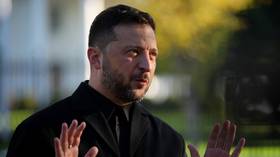Bush advisor: Hastings crash ‘consistent with a car cyberattack’

A former cybersecurity advisor to President George W. Bush says a sophisticated computer hack could have been the cause of the automobile accident that claimed the life of journalist Michael Hastings last week in Los Angeles.
Richard Clarke, a State Department official-turned-special advisor to several United States presidents, said the early morning auto crash last Tuesday was "consistent with a car cyberattack,” raising new questions about the death of the award-winning journalist.
Hastings died last week when his 2013 Mercedes C250 coupe collided with a tree in Los Angeles, California on the morning of June 18. He was reportedly traveling at a high rate of speed and failed to stop at a red light moments before the single-car crash. He was only 33.
Speaking to Huffington Post this week, Clarke said that a cyberattack waged at the vehicle could have caused the fatal collision.
"What has been revealed as a result of some research at universities is that it's relatively easy to hack your way into the control system of a car, and to do such things as cause acceleration when the driver doesn't want acceleration, to throw on the brakes when the driver doesn't want the brakes on, to launch an air bag," Clarke told The Huffington Post. "You can do some really highly destructive things now, through hacking a car, and it's not that hard."
"So if there were a cyberattack on the car — and I'm not saying there was," Clarke continued, "I think whoever did it would probably get away with it."
The Los Angeles Police Department said they don’t expect foul
play was involved in the crash, but an investigation has been
opened nonetheless.
In an email reportedly sent by Hastings hours before the crash, he told colleagues that he thought he was the target of a federal investigation.
“Hey [redacted}, the Feds are interviewing my ‘close friends and associates,’” Hastings wrote 15 hours before the crash.

“Also: I’m onto a big story, and need to go off the rada[r] for a bit,” he added. “All the best, and hope to see you all soon.”
The email was supplied to KTLA News in Los Angeles by Staff Sgt. Joseph Biggs, who says he met Hastings while the journalist was embedded in Afghanistan in 2008. It was reportedly send to a handful of Hastings’ associates and was blind-copied to Biggs.
“I just said it doesn’t seem like him. I don’t know, I just had this gut feeling and it just really bothered me,” Biggs told KTLA.
Reporters at Buzzfeed where Hastings worked say they received an email from their colleague, but the Federal Bureau of Investigation issued a statement two days after Hastings’ death to quash rumors that they had been looking into the reporter.
“At no time was Michael Hastings under investigation by the FBI,” FBI spokeswoman Laura Eimiller said.
According to the Associated Press, however, Hastings’ fingerprints were on file with the FBI and were used by the bureau to identify his body after flames consumed much the auto wreckage last week.
"I believe the FBI when they say they weren't investigating him," Clarke told the Huffington Post. "That was very unusual, and I'm sure they checked very carefully before they said that."
"I'm not a conspiracy guy. In fact, I've spent most of my life knocking down conspiracy theories," he said. "But my rule has always been you don't knock down a conspiracy theory until you can prove it [wrong]. And in the case of Michael Hastings, what evidence is available publicly is consistent with a car cyberattack. And the problem with that is you can't prove it."
Clarke, 62, spent nearly two decades at the Pentagon before relocating to the White House where he served under President Ronald Reagan and both Presidents Bush. He served as special advisor to President George W. Bush on cybersecurity until leaving the administration in 2003 and is currently the chairman and CEO of Good Harbor Security Risk Management, LLC.














